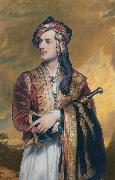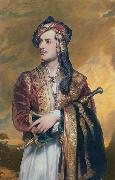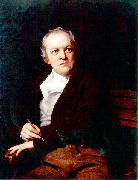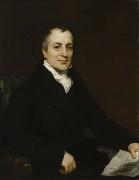Thomas Phillips Huiler la Reproduction de TableauAll Thomas Phillips Oil Paintings(18 October 1770 - 20 April 1845) was a leading English portrait and subject painter. He painted many of the great men of the day including scientists, artists, writers, poets and explorers. Phillips was born at Dudley then in Worcestershire. Having acquired the art of glass-painting in Birmingham under Francis Eginton,[1] he visited London in 1790 with an introduction to Benjamin West, who found him employment on the painted-glass windows of St George's Chapel at Windsor. In 1791, he became a student of the Royal Academy, and exhibited there, in 1792, a view of Windsor Castle, followed in the next two years by the "Death of Talbot, Earl of Shrewsbury, at the Battle of Castillon," "Ruth and Naomi," "Elijah restoring the Widow's Son," "Cupid disarmed by Euphrosyne," and other pictures. After 1796, he mainly confined himself to portrait-painting. However, the field was very crowded with the likes of John Hoppner, William Owen, Thomas Lawrence and Martin Archer Shee competing for business; consequently, from 1796 to 1800, his exhibited works were chiefly portraits of gentlemen and ladies, often nameless in the catalogue and of no great importance historically-speaking. |
|||

|
|||
|
|
|||
|
||||||||||||
| Thomas Phillips (18 October 1770 - 20 April 1845) was a leading English portrait and subject painter. He painted many of the great men of the day including scientists, artists, writers, poets and explorers. Phillips was born at Dudley then in Worcestershire. Having acquired the art of glass-painting in Birmingham under Francis Eginton,[1] he visited London in 1790 with an introduction to Benjamin West, who found him employment on the painted-glass windows of St George's Chapel at Windsor. In 1791, he became a student of the Royal Academy, and exhibited there, in 1792, a view of Windsor Castle, followed in the next two years by the "Death of Talbot, Earl of Shrewsbury, at the Battle of Castillon," "Ruth and Naomi," "Elijah restoring the Widow's Son," "Cupid disarmed by Euphrosyne," and other pictures. After 1796, he mainly confined himself to portrait-painting. However, the field was very crowded with the likes of John Hoppner, William Owen, Thomas Lawrence and Martin Archer Shee competing for business; consequently, from 1796 to 1800, his exhibited works were chiefly portraits of gentlemen and ladies, often nameless in the catalogue and of no great importance historically-speaking. |
||||||||||||
|
|
||||||||||||
| ID de tableau:: 74491 Lord Byron in Albanian dress Lord Byron in Albanian dress 1835(1835) Oil on canvas 76.5 X 63.9 cm cjr 1835(1835) Oil on canvas 76.5 X 63.9 cm cjr |
||||||||||||
|
|
||||||||||||
| ID de tableau:: 75966 Lord Byron in Albanian dress Lord Byron in Albanian dress Date 1835(1835) Medium Oil on canvas Dimensions 76.5 x 63.9 cm cyf Date 1835(1835) Medium Oil on canvas Dimensions 76.5 x 63.9 cm cyf |
||||||||||||
|
|
||||||||||||
| ID de tableau:: 84091 Charles Dibdin Charles Dibdin Date 1799 cyf Date 1799 cyf |
||||||||||||
|
|
||||||||||||
| ID de tableau:: 94437 Portrait of William Blake Portrait of William Blake 1807(1807) Medium painting cjr 1807(1807) Medium painting cjr |
||||||||||||
|
|
||||||||||||
| ID de tableau:: 97224 David Ricardo David Ricardo circa 1821 Medium oil on canvas Dimensions 36 1/8 in. x 28 in. cyf circa 1821 Medium oil on canvas Dimensions 36 1/8 in. x 28 in. cyf |
||||||||||||
|
|
||||||||||||
|
| Artiste précédent Artiste prochain | |||||||||||
|
|
||||||||||||
|
Thomas Phillips (18 October 1770 - 20 April 1845) was a leading English portrait and subject painter. He painted many of the great men of the day including scientists, artists, writers, poets and explorers. Phillips was born at Dudley then in Worcestershire. Having acquired the art of glass-painting in Birmingham under Francis Eginton,[1] he visited London in 1790 with an introduction to Benjamin West, who found him employment on the painted-glass windows of St George's Chapel at Windsor. In 1791, he became a student of the Royal Academy, and exhibited there, in 1792, a view of Windsor Castle, followed in the next two years by the "Death of Talbot, Earl of Shrewsbury, at the Battle of Castillon," "Ruth and Naomi," "Elijah restoring the Widow's Son," "Cupid disarmed by Euphrosyne," and other pictures. After 1796, he mainly confined himself to portrait-painting. However, the field was very crowded with the likes of John Hoppner, William Owen, Thomas Lawrence and Martin Archer Shee competing for business; consequently, from 1796 to 1800, his exhibited works were chiefly portraits of gentlemen and ladies, often nameless in the catalogue and of no great importance historically-speaking. |
||||||||||||
|
|
||||||||||||
|
CONTACTER DES Etats-Unis |










